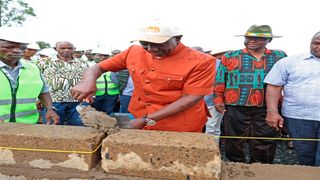
President William Ruto (centre) during the launch of Mabera Affordable Housing Project in Migori County.
| Courtesy | PCSBusiness
Premium
Why Ruto's $3b plan for cheap houses ran aground
Even before the High Court ruled that the controversial housing levy for President William Ruto's legacy project was unconstitutional, there were signs that the affordable housing scheme was facing headwinds.
When the scheme was mooted, the government struggled to raise the Ksh500 billion ($3.2 billion) needed to pay developers, forcing it to turn to the levy on employees and employers.
So, the Ruto administration quietly reviewed the plan to build 200,000 housing units per year after the plan to raise Ksh1 trillion ($6.5 billion) in five years seemed to flounder, courtesy of the prevailing high interest rate regime.
The EastAfrican understands that the government failed to raise the initial instalment of Ksh500 billion ($3.2 billion) from a group of financial sector players to kick off the project, after interest rates jumped from about 13 per cent to around 17 per cent in 12 months, causing developers to reject the housing contracts.
So, the High Court decision against the implementation of the controversial housing levy of 1.5 per cent per month by salaried workers plus a similar amount from the employers, even though with stay orders until January 10, presented a new challenge to an already struggling programme.
The three-judge bench declared the housing levy unconstitutional for being discriminatory and creating unequal principles. The judges ruled that Section 84 of the Finance Act, which amends the Employment Act to introduce the Housing Levy, violates the principles of taxation for making distinction between formal and informal sectors, thus creating unequal and inequitable principles.
The court added that the enactment of laws must be supported with a rational explanation but, in the case of the housing levy, the government failed to provide an explanation for the imposition of the tax or a legal framework to anchor the fees.
Kenyans may, therefore, wait a bit longer to move into the affordable houses promised by the government.
The levy that was introduced through the Finance Act (2023) is a push by the State to implement the housing plan pledged during the election campaigns last year. But the amount to be collected in a year is a paltry Ksh84 billion ($552.6 million) compared with the projected Ksh500 billion ($3.2 billion) under the private sector-led fundraising model.
Sources say the government is collecting Ksh7 billion ($46 million) every month from both the employees and employers.
President Ruto had hoped to mobilise Ksh1 trillion ($6.5 billion) towards the construction of affordable houses in five years through the Sanduku Investment initiative, which brings together financial sector players, including the pensions industry, insurance firms, banks, Saccos, fund managers, co-operatives, stockbrokers and investment banks.
Of the Ksh1 trillion, half was to be raised in the first year, which ended in November, and then Ksh125 billion ($816 million) for each of the remaining four years.
The EastAfrican, however, understands that high interest rates have made it difficult for developers to borrow and finance the construction of these houses.
Tom Mulwa, chairman of the Sanduku Investment Initiative, which has since transformed into Kenya National Reits (KNR), a company limited by guarantee, told The EastAfrican that high interest rates have “caused a very big challenge for the capital markets.”
“Because of that, we realised that we had to quickly rejig our thinking on how to support the government’s agenda on infrastructure,” he said.
KNR seeks to promote the growth and uptake of Reits and infrastructure investment trusts as an investment grade stock. It was also tasked with identifying and institutionalising a resource mobilisation plan to raise Ksh500 billion in the first year to fund the housing plan.
Under the initial implementation plan, developers were to finance the construction of the houses on their own and then expect to be exited (paid off) by either of the financial sector players, who then off takes the houses and converts them into real estate investment trusts (REITs) to be traded on the Nairobi Securities Exchange (NSE).
However, this plan did not work out as a result of soaring interest rates that made bank loans more expensive.
Developers declined to take up the projects, largely due to high cost of bank loans, uncertainty over the government’s ability to repay its debts, and unwillingness to take the risk of putting up units in remote counties away from Nairobi and Mombasa.
“The original idea before the housing levy was that the government identify house buyers, identify developers and then we (group of financial sector players) finance those house buyers by the way of a Reits. Now, the challenge was that the developers were not willing to go to a site without seeing the money first. That is how the government decided on the levy,” Mr Mulwa said.
“Most of the developers faced challenges with finance when the interest rate moved from 12 per cent to more than 16 per cent. It was not tenable,” he said.
In November 2022, President Ruto said the government would no longer borrow money at interest rates of over 10 per cent, as the country’s cost of debt had become “unacceptable.”
At the time, the State had borrowed Ksh60 billion ($391 million) from the domestic market through a 14-year Treasury bond priced at 13.93 per cent.
The government then set out to persuade commercial banks, pension funds and insurance companies to transfer their Ksh4.12 trillion ($27.1 billion) worth of investment in government securities into real estate investments at the NSE to fund the housing plan through the Sanduku Investment Initiative.
The EastAfrican has learnt that developers turned down the request.
The government is identifying developers for all the housing projects.
Kenya’s housing demand stands at 250,000 units per year compared to the supply of 50,000 units, while mortgages uptake is still low, with just 23,000 home loans in the market.




